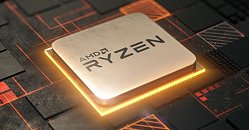Raevenlord
News Editor
- Joined
- Aug 12, 2016
- Messages
- 3,755 (1.20/day)
- Location
- Portugal
| System Name | The Ryzening |
|---|---|
| Processor | AMD Ryzen 9 5900X |
| Motherboard | MSI X570 MAG TOMAHAWK |
| Cooling | Lian Li Galahad 360mm AIO |
| Memory | 32 GB G.Skill Trident Z F4-3733 (4x 8 GB) |
| Video Card(s) | Gigabyte RTX 3070 Ti |
| Storage | Boot: Transcend MTE220S 2TB, Kintson A2000 1TB, Seagate Firewolf Pro 14 TB |
| Display(s) | Acer Nitro VG270UP (1440p 144 Hz IPS) |
| Case | Lian Li O11DX Dynamic White |
| Audio Device(s) | iFi Audio Zen DAC |
| Power Supply | Seasonic Focus+ 750 W |
| Mouse | Cooler Master Masterkeys Lite L |
| Keyboard | Cooler Master Masterkeys Lite L |
| Software | Windows 10 x64 |
A post via Chiphell makes some substantial claims on AMD's upcoming Zen 2 microarchitecture, built on the 7 nm process. AMD has definitely won the core-count war once again (albeit with a much more decisive blow to Intel's dominance than with Bulldozer), but the IPC battle has been an uphill one against Intel's slow, but sure, improvement in that area over the years. AMD did say, at the time they introduced the Zen architecture, that they had a solid understanding on Zen's choke points and its improveable bits and pieces - and took it to heart to deliver just that.

A 10 to 15% improvement should bring AMD close to Intel's Kaby Lake solutions in pure per-core, single-thread performance - with the possibility for higher performance in multithreaded workloads even at the same clocks and core counts, since AMD's SMT implementation and per-core communication seems to best that of even Intel's Coffee Lake chips. Add to that the sure clock increases AMD will bring to their Zen 2 parts - you can bet the power consumption and top frequency benefits for the 7 nm manufacturing process (some estimated 1.6X logic density, ~20% speed improvement, and ~40% power reduction compared to TSMC's 10 nm process) won't go to waste when they can be used for an even greater performance uplift.

Add to that the possibility -also posted via the Chiphell thread) of a per-CCX core-count increase of 8 cores per CCX (with 16-core parts being available for the consumer products) and a purely hypothetical claim for the performance crown now seems not only plausible, but likely.
View at TechPowerUp Main Site

A 10 to 15% improvement should bring AMD close to Intel's Kaby Lake solutions in pure per-core, single-thread performance - with the possibility for higher performance in multithreaded workloads even at the same clocks and core counts, since AMD's SMT implementation and per-core communication seems to best that of even Intel's Coffee Lake chips. Add to that the sure clock increases AMD will bring to their Zen 2 parts - you can bet the power consumption and top frequency benefits for the 7 nm manufacturing process (some estimated 1.6X logic density, ~20% speed improvement, and ~40% power reduction compared to TSMC's 10 nm process) won't go to waste when they can be used for an even greater performance uplift.

Add to that the possibility -also posted via the Chiphell thread) of a per-CCX core-count increase of 8 cores per CCX (with 16-core parts being available for the consumer products) and a purely hypothetical claim for the performance crown now seems not only plausible, but likely.
View at TechPowerUp Main Site



 ). There are a few scenarios, one thing is for sure, it is interesting to watch.
). There are a few scenarios, one thing is for sure, it is interesting to watch.



